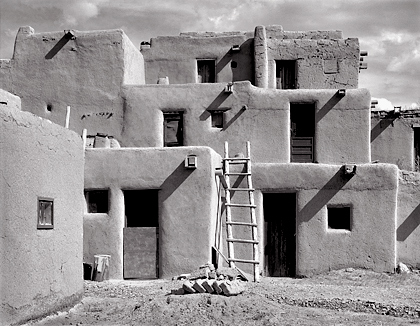 Taos and its setting: The first European explorers of the Taos Valley came here with Captain Hernando de Alvarado, a member of Francisco Vásquez de Coronado's expedition of 1540. Basque explorer Don Juan de Oñate arrived in Taos in July 1598 and established a mission and trading arrangements with
Taos and its setting: The first European explorers of the Taos Valley came here with Captain Hernando de Alvarado, a member of Francisco Vásquez de Coronado's expedition of 1540. Basque explorer Don Juan de Oñate arrived in Taos in July 1598 and established a mission and trading arrangements withresidents of Taos Pueblo. The settlement developed into two plazas: the Plaza at the heart of the town became a thriving business district for the early colony, and a walled residential plaza was constructed a few hundred yards behind. It remains active today, home to a throng of gift and coffee shops. Taos Plaza is, for historical reasons, one of the few places in the country where the U.S.flag may properly be displayed continuously (both day
and night).
Beginning in 1899, artists began to settle in Taos and created the "Taos Society of Artists". In time the Taos art colony developed. Many paintings were made of local scenes, especially of Taos Pueblo and activities there.
Taos is now one of the major tourist attractions in the Southwest. With its skiing and dining, and historical sites.
The town is attracting the attention of Hollywood with famous residents such as Julia Roberts, Val Kilmer, and Donald Rumsfeld among others.
Taos is nestled at the base of the Sangre de Cristo Mountains, literally translated 'The Blood of Christ' because of the spectacular reddish color they can turn at sunset.
The Sangre de Cristo Mountains are one of the longest mountain chains on Earth. They stretch from Poncha Pass, Colorado, in the north to Glorieta Pass, New Mexico, in the south. There are ten peaks over 14,000' high in the range, more than two dozen over 13,000'.
The Rio Grande Gorge Bridge is a cantilever truss bridge across the Rio Grande Gorge 10 miles (16 km) northwest of Taos, New Mexico, United States. At 650 feet (200 m) above the Rio Grande, it is one of the highest bridges in the United States. The span is 1,280 feet (390 m): two 300-foot (91 m)-long approach spans with a 600-foot (180 m)-long main center span. The
bridge was dedicated on September 10, 1965 and is a part of U.S. Route 64, a major east-west road.
In 1966 the American Institute of Steel Construction awarded the bridge "Most Beautiful Steel Bridge" in the "Long Span" category. The bridge has appeared in several films, including Natural Born Killers, Twins, She's Having a Baby, Wild Hogs and the new Terminator movie.

The Gorge of the Rio Grande: This river, or at least the section that runs through northern New Mexico, is not a typical river that has carved out its own valley. Rather, the valley appeared first and the river followed. This 'rift valley' is a separation in the earth's crust caused by faulting and
other earth movements when the North American and Pacific plates scraped against each other some twenty-nine million years ago.
The Rio Grande Rift is not just the canyon, or gorge, that holds the river, but an area of more than 160,000 square miles reaching from central Colorado almost to Big Bend National Park in Texas. Taos Plateau is part of this 'rift system' and lies in the San Luis Basin, which is nearly a hundred miles long and about forty-seven miles wide.
As pressures from the scraping plates caused the earth's crust to crinkle, Colorado and New Mexico rose nearly 5,000 feet. Basaltic magma surged upward from the mantle, forcing weaker areas of the surface to spread. Fault-enclosed basins called grabens dropped several thousand feet lower than adjacent land. Blocks of the earth's crust fell into some of these grabens, deepening them. Sediments including sand, gravel, volcanic lava, and ash filled the grabens to depths of four and a half miles in some places.
The Church of San Francisco de Asis , at Ranchos de Taos is considered by many to be the most beautiful edifice in the State of New Mexico. A powerful and luminous landmark, it is as elegantly simple and dignified an example as ever graced a Southwest horizon.
The intimate connection in the Spanish mind between religion and everyday life is the inspiration for this magnificent building. It was built in the eighteenth century by the hands of Spanish settlers and their Pueblo Indian neighbors, who shaped and laid the adobe bricks of clay, sand and straw. In the summer of 1979, the descendants of these original architects rebuilt the
church with methods and materials that have varied little in over 200 years.
Many artists, photographers and writers have tried to capture the ageless quality of the building's subtle lines and broad earthen planes and it is one of the most famous sights in the world.
Randy and Sondra Phillips
http://www.coast2coast-usa.org/
www.myspace.com/coast2coastusa
http://www.justgiving.com/coast2coast-usa






No comments:
Post a Comment